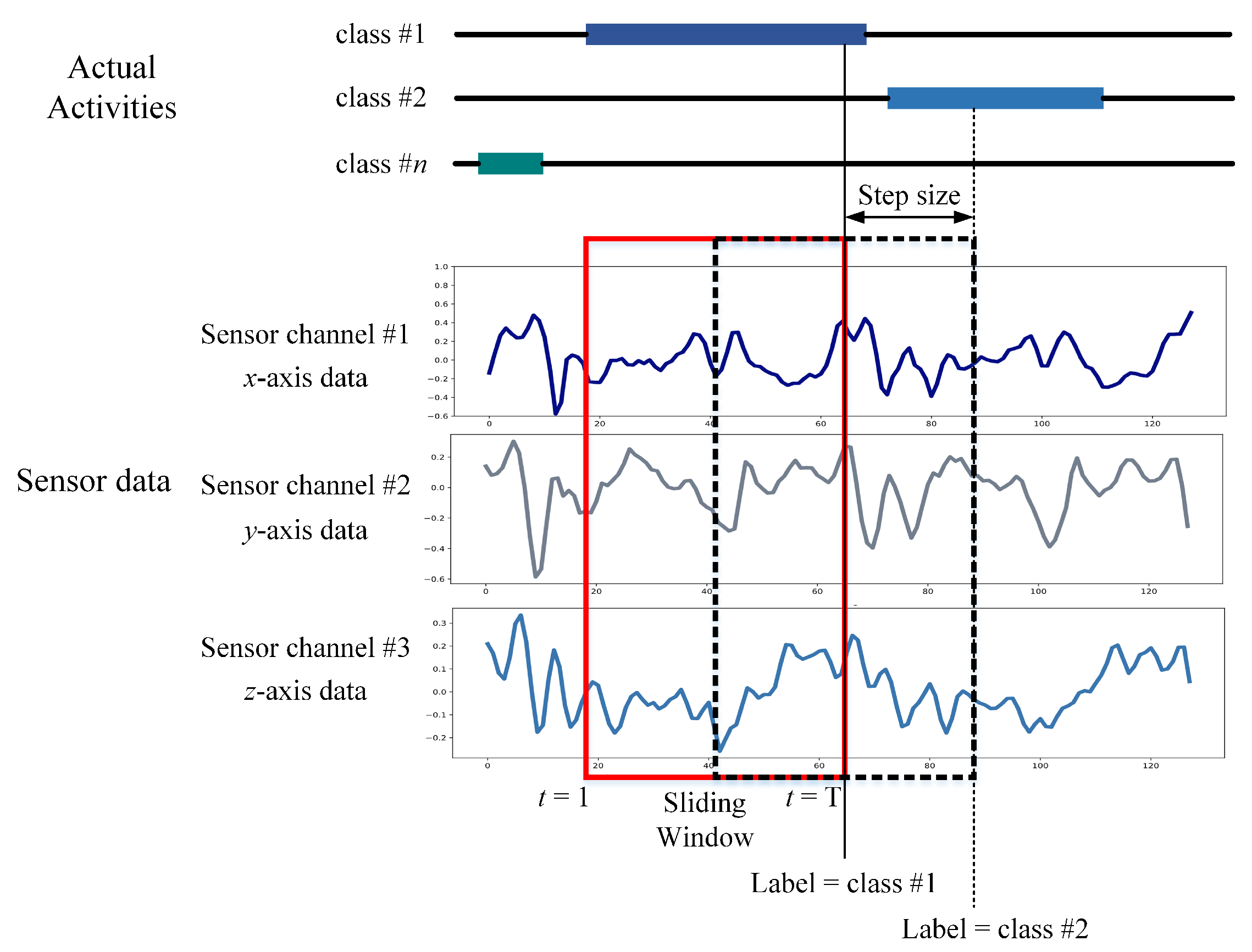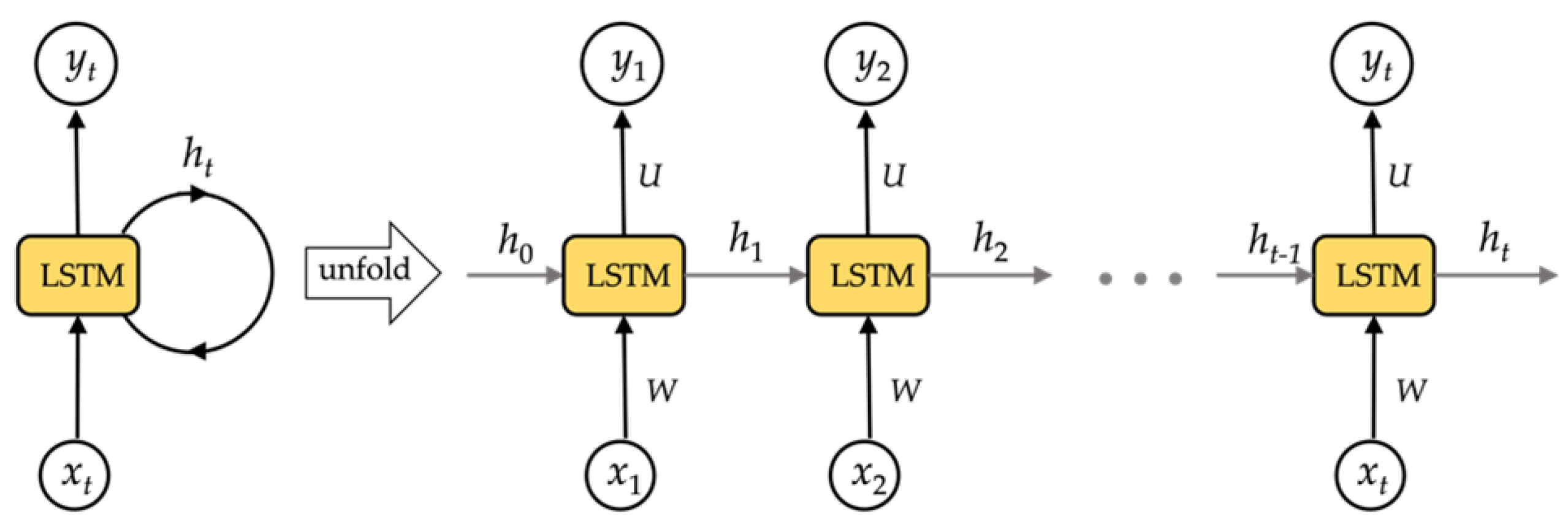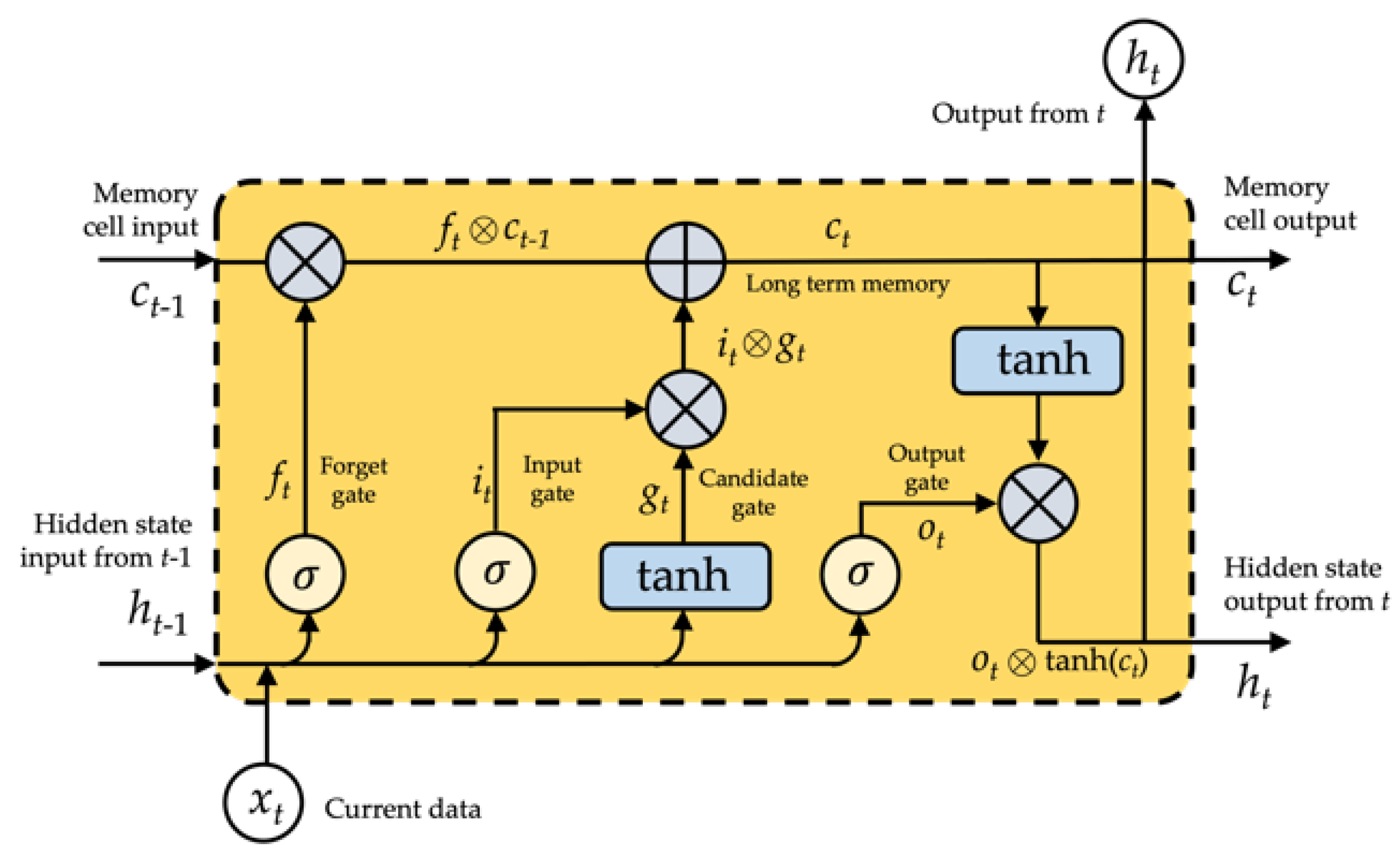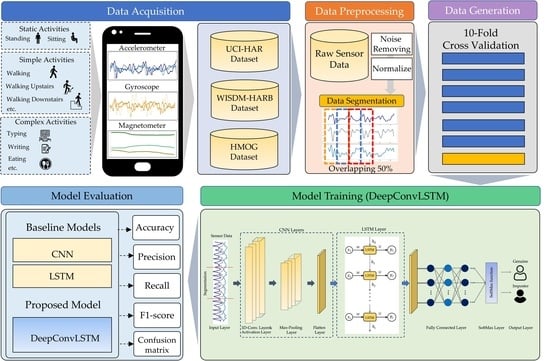This research study proposed DeepAuthen as a continuous authentication architecture based on deep learning using smartphone sensors. DeepAuthen was presented as a framework for continuous authentication that gathers data from smartphone sensors and feeds it to an authentication model to validate smartphone users. We investigated smartphone users’ unique use and activity patterns recorded by the sensor data used for continuous authentication.
3.2. Data Acquisition
There are many public datasets available for collecting smartphone sensor data for the purpose of human activity recognition (HAR). However, these datasets are typically insufficient for continuous authentication mechanisms because data are collected in controlled situations using fixed-mounted smartphones or released without subject information. One exception is the Human Activity Recognition using Smartphone (UCI-HAR) dataset [
40], which is a collection devoted to activity recognition. The dataset has also been utilized for continuous authentication [
24]. Another notable exception is the WISDM-HARB dataset, which gathers data on activity patterns to investigate activity identification and authentication using smartphone sensors. The third dataset utilized in this study was a publicly accessible dataset that gathered data specifically for continuous authentication [
41], commonly referred to as the Hand Movement, Orientation, and Grasp (HMOG) dataset, generated by 100 participants throughout 24 periods using inertial and touch sensors. Participants were required to complete specified tasks throughout these periods. Each of the three datasets utilized in this study, as shown in
Table 2, is described in detail as follows:
3.2.1. UCI-HAR: Human Activity Recognition Using Smartphone Dataset
Various public datasets are available to gather smartphone sensors, but the UCI-HAR dataset [
40] combines smartphone sensing data from 30 volunteers aged 19–48 years. In everyday life, each participant engaged in six events: walking, walking upstairs, walking downstairs, sitting, standing, and lying down. Activity data were collected using a smartphone worn around the waist. At a fixed rate of 50 Hz, the sensor data consisted of triaxial linear acceleration and triaxial angular velocity. The data were manually tagged to indicate the activity and the individual participant.
3.2.2. WISDM-HARB: WISDM Human Activity Recognition and Biometric Dataset
The WISDM-HARB dataset [
42] contains details from 51 participants who were required to complete 18 everyday tasks involving both simple and complex activities. For this dataset, the accelerometer and gyroscope data were collected at a steady rate of 20 Hz from smartphones and smartwatches while each participant performed these tasks for three minutes. The data were manually tagged to indicate the kind of activity and the individual participant.
This study used data from the WISDM-HARB dataset for smartphones by conducting an exploratory investigation on the sensor data. We observed that human activity data for seven individuals did not include all predefined activities and ignored the seven subjects (1616, 1618, 1637, 1638, 1639, 1640, and 1642). As a result, 44 subjects retained their smartphone data.
3.2.3. HMOG: Hand Movement, Orientation, and Grasp Dataset
The HMOG has been assembled and released as publicly accessible [
41]. The dataset contains accelerometer, gyroscope, and magnetometer information of tap-based characteristics such as x-y coordinates, finger-covered area, and pressure gathered from 100 smartphone users throughout 24 periods. The data were gathered in a controlled setting during several periods of smartphone use. Each period consisted of specified activities categorized as reading, writing, or map-navigation. Furthermore, each activity was conducted when both sitting and walking. Each experience was repeated four times, yielding a total of 24 experiences for each participant. The dataset contained accelerometer, gyroscope, and magnetometer sensor data, with frequency operation at 100 Hz. Each individual recorded six distinct experience patterns. Additionally, sensor information from screen interactions such as touch, keypress, scroll, pinch, and stroke were recorded, but these were irrelevant for this study.
However, specific periods were not finished owing to outlier data and missing data for some individuals in the HMOG dataset. Büch [
43] determined that participant 733162 lacked accelerometer data for periods 9, 10, 11, 12, 13, and 14, while subjects 526319 and 796581 recorded only 23 periods instead of 24. As a result, we eliminated participants 526319, 796581, and 733162 from our active dataset. Li et al. [
44] indicated two patients with anomalous results in HMOG but provided no additional explanations. These were presumed to be participants 526319 and 796581. The study by Centeno et al. [
45] excluded ten participants from the HMOG dataset. Seven more subjects with inconsistent data were eliminated to maintain comparability with their study, while Büch’s logic [
43] eliminated participants 256487, 389015, and 856401 as a result of excessive data compared to the mean, and participants 219303, 539502, 737973, and 986737 for having insufficient data.
3.3. Data Preprocessing
The preprocessing stage involves the preparation of raw sensor readings for subsequent steps in the proposed framework of continuous authentication. It comprises cleaning, transforming, and segmenting raw data. The cleaning step minimizes the noise using a median filter and a third-order low-pass Butterworth filter with a cutoff frequency of 20 Hz. This rate is adequate for collecting human movement since 95% of its energy is stored under 15 Hz [
40]. Regarding noise filtering, the data are converted into the proper representations for the following step. In particular, the transformation step employs a Min-Max normalization method to visualize each data point’s values onto the range [0, 1]. It would support learning algorithms in balancing the impacts of different dimensions. All sensors’ normalized data are mapped to the exact size of a sliding window for the data segmentation step. In this study, we formed sensory data sequences with a duration of 2.56 s using a sliding window (128 readings for each sequence in the UCI-HAR dataset, 52 readings for each sequence in the WISDM-HARB dataset, and 256 readings for each sequence in the HMOG dataset).
In sensor-based HAR, the initial step is to generate data samples from raw sensor data. This procedure involves segmenting the raw data into identically sized short segments named temporal windows. Before training a deep learning model, raw time series data collected from wrist-worn wearable sensors is segmented into temporal segments in this study. Sliding is a commonly used method that is useful for managing flowing data. Each time interval is equal to the window size specified by
t. The
denotes
X,
Y, and
Z readings throughout the time interval [
t,
t]. This study used a data segmentation technique called an overlapping temporal window (OW), which generates data samples by applying a fixed-size window to the sensor data stream. The OW technique is the most often employed in sensor-based HAR and authentication research, with a 50% overlap rate [
23,
24]. Nevertheless, this sample generation is considerably unbalanced since
and
share a percentage of the sensor data.
Figure 2 illustrates an example of sensor data segmentation using the OW scheme.
X,
Y, and
Z denote the three main components of a triaxial IMU sensor.
3.4. Proposed Deep Learning Network
This research addresses a deep learning model called DeepConvLSTM for continuous authentication utilizing data from smartphone sensors.
Figure 3 illustrates the proposed DL network structure for continuous authentication based on activity characteristics. The proposed CA model comprises two components: the CNN network is responsible for extracting spatial characteristics from sensory input. Additionally, the LSTM network is responsible for extracting temporal dependency relations in spatial features.
Convolutional neural networks (CNNs) are commonly used deep learning models with significant feature extraction properties. The CNNs can progressively extract spatial information from the input data in an automated and efficient manner. CNNs are especially adept at processing two-dimensional image information compared to one-dimensional data such as physical or business data. The convolutional layers’ inputs are linked to the subsequent layers rather than completely connected as in conventional neural network models. Because both input sets have the same weights for subregions, the CNN’s inputs generate spatially linked outputs. However, in conventional neural network networks (NN), each input has a unique weight. Increasing the number of weights raises the input dimensionality, resulting in a more complicated network. In comparison to NN, CNN uses weight sharing and downsampling to decrease the weights and the number of connections. In the proposed model, the first convolutional layer in this study has 64 filters and a kernel size of three. The second layer has 64 filters and a kernel of size 5, whereas the pool size in the max-pooling layers has always been set to two. A flattening layer was utilized to link the convolutional and LSTM layers. The CNN subnetwork’s hyperparameters are listed in
Table 3.
While CNNs are rather efficient at extracting features, they are less effective for certain classification/learning problems, including time-dependent inputs, such as the smartphone sensing data used in this work. Because the prior situation this kind of data impacts the network’s forecasts of future situations, the network would have to be aware of both the present and previous inputs. This issue could be addressed using an RNN model capable of performing classification on each aspect of a time series. The RNN describes the present input as of the previous time step and as the outcome of the prior input. The result of the RNN at time t is influenced by the output of the RNN at time step t − 1.
RNN networks could technically be used to train for time series data of any length. In reality, RNN networks struggle from gradient disappearance when dealing with multiple time series, making it impossible to learn long-range relationships. To resolve this concern, we use a long- and short-term memory storage unit as the RNN network’s storage unit, the LSTM network. The LSTM architecture is shown in
Figure 4.
Employing complex systems termed gates, LSTM effectively eliminates or adds information to cellular states. The gate is a technique for deliberately allowing information to flow through. It is composed of a layer of sigmoid neural networks and a pointwise multiplication function. Three gates safeguard and regulate the state of an LSTM cell: a forget gate, an input gate, and an output gate, as shown in
Figure 5.
In this work, we denote an LSTM layer’s input set as
X = {
,
,
, …,
,
, …}, its output set as
Y = {
,
,
, …,
,
, …}, and its hidden layers as
H = {
,
,
, …,
,
, …}. Moreover,
U,
W, and
V represent the layer’s weight metrics.
U indicates weight metrics between the input and hidden layers,
W represents weight metrics between the hidden and hidden layers, and
V denotes weight metrics between the hidden and output layers, respectively. The LSTM network’s computational method is as follows: the input data are converted into the hidden layer using a matrix transformation, coupled with the information from the hidden layer in the final step. Then, as shown in
Figure 5, the result of the hidden layer is passed through an activation function to determine the final value of the output layer.
The hidden layer’s and output layer’s outputs could be specifically defined:
As shown in
Figure 5, the LSTM’s input gate (
i) forget gate (
f), output gate (
o), and memory cell (
c) are all intended to regulate what information should be forgotten, recalled, and updated. Gating is a technique that allows for the controlled transmission of data. It is comprised of two functions: a sigmoid and an element-wise multiplication. The output value must fall inside the range [0, 1] for multiplication to occur, allowing or preventing information flow. It is regarded best practice to calibrate these gates to 1 or near to 1 to avoid impairing training in the starting. Each parameter may be specified as follows in the LSTM unit at time
t.
The forget gate
is involved for eliminating irrelevant past information; the recurrent input
(
m is the size of the hidden state) and current input
(
n is the length of the input) are inputs to a sigmoid function
=
, the output
is a value between 0 and 1 multiplied by the cell state (
), if
equals 1, the LSTM retains this new information; alternatively, if
equals 0, the LSTM discards this additional information entirely:
The input gate
is a sigmoid function, and the output is the value that is used to modify the LSTM cell:
The state gate
generates a vector of variable length. These values are added to and perform a status update:
The output gate
indicates the data from the cell state that should be produced instantaneously in combination with previously stored information:
The update state
entails forgetting what should be remembered and adding what should be added:
The LSTM’s hidden output
combines both short and long periods.
where
denotes element-wise multiplication and
denotes element-wise addition,
,
,
,
, where
m denotes the weighted matrices of the recurrent input
,
,
,
,
, where
n denotes the weighted matrices of the current input
,
,
,
,
.
The LSTM cell’s information processing is given in Equations (3)–(7). To beginning, there is a requirement to forget previous knowledge, which is accomplished through the forget gate. The next stage is to use an input gate to decide what additional information needs to be stored in memory. This allows for the updating of the previous cell state, , to the new cell state, . Finally, it determines which information should be sent through an output gate to the layer above.
In the proposed model, three dense layers with drop out were linked following the LSTM layer. The first dense layer has 128 neurons with a 0.25 dropout, followed by a layer of 64 neurons with a 0.25 dropout, and finally, the output layer contains two neurons. The activation function for each layer in the model is a rectified linear unit (ReLU).
The setup that performed optimally throughout the training procedure was 50 epochs with a batch size of 32. The categorical cross entropy with Adam optimizer was used as the loss function [
46].





















